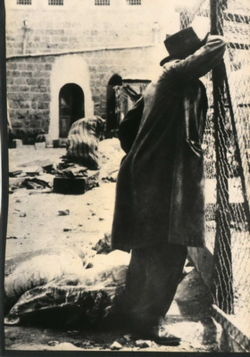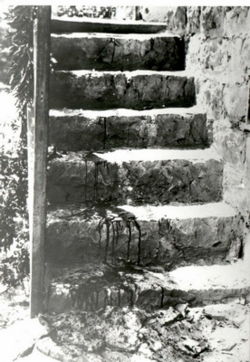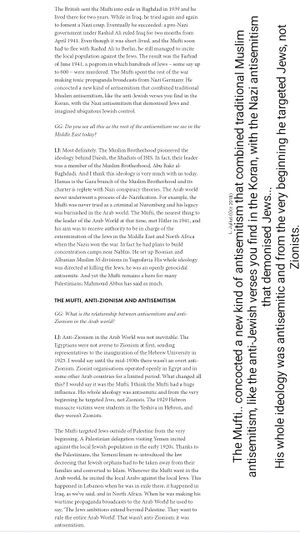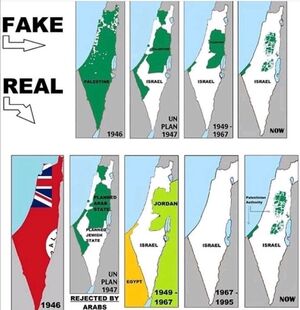1929 Hebron Massacre
 From Conservapedia
From Conservapedia 

The Hebron Massacre (sometimes referred to as the Hebron Pogrom) took place in Hebron, Palestine in 1929. It began when a yeshiva student named Shmuel Rosenholtz, was attacked by an Arab mob and stabbed to death. Only one British policeman guarded the entire city.[1] By the time British reinforcements arrived to restore order, 67 Jews had been slaughtered and many others seriously wounded. Babies had been beheaded, rabbis castrated, and others raped, tortured and mutilated; hands and fingers were cut off both the living and the dead, apparently for jewelry.[2][3][4]
Contents
- 1 Background
- 2 First disturbances
- 3 August 23
- 4 The Hebron massacre
- 5 Arab assistance
- 6 Arab deceit
- 7 Hebron liberated
- 8 References
Background[edit]
Hebron (Hebrew: חֶבְרוֹן Hevron "to be joined") is the second holiest city after Jerusalem in Judaism. Although small in 1929 (around 100 Jewish families, among an Arab population of 60,000)[5] the Jewish community had lived alongside the Arabs there for centuries. The Sephardi Jews spoke Arabic and many of their Arab neighbours conversed with the Ashkenazi Jews in Yiddish.[6] During the summer of 1929, however, the Islamic Grand Mufti of Jerusalem and head of the Supreme Muslim Council, Haj Amin al-Husseini, began to agitate the Arabs to riot against the Jewish community, distributing leaflets and stirring up anti-Jewish sentiment. Among these were leaflets stating that the Jews were planning to take over the al-Aqsa Mosque.[7] Another stated: "Hearts are in tumult because of these barbaric deeds, and the people began to break out in shouts of 'war, Jihad... rebellion.'... O Arab nation, the eyes of your brothers in Palestine are upon you... and they awaken your religious feelings and national zealotry to rise up against the enemy who violated the honor of Islam and raped the women and murdered widows and babies." The Jews had killed no-one, and had attacked no-one.[8] Pierre van Paassen, the international correspondent for the New York Evening World, met with the Mufti around this time and described him as a man driven by a petrifying rage against Jews. During this meeting the Mufti also claimed that Albert Einstein planned to have the Dome of the Rock demolished to make way for a giant synagogue.[9][10] Al-Husseini had been appointed mufti by Herbert Samuel, the first high commissioner of Palestine, despite his conviction and ten-year prison sentence for inciting earlier anti-Jewish riots in 1920. Al-Husseini had fled capture however, and become a fugitive in Transjordan. It seems that he struck a deal with the British shortly afterwards, using his influence to end riots in 1921. He assured Samuel that he would continue to maintain order, and it was with this understanding that the high commissioner granted him amnesty and the position of Mufti.[11]
First disturbances[edit]
Arab abuse against the Jews became a daily occurrence, and complaints were made to the British police that they were not doing anything to protect them. There are many indications that the British authorities had advance warning of the disturbances, yet did nothing to try to head them off. Journalist/author Shlomo Hersh details[12] several eyewitness accounts of the events leading up to the Hebron massacre which bear this out.
- Dr. Elkana of Hebron: "For many days before the horror began, the poison of incitement was felt everywhere. The Arabs spoke openly, shamelessly, and fearlessly of the massacre of the Jews to be arranged in the near future. They did not hesitate to reveal their whole detailed plan. Facts and evidence are in the hands of the survivors. The landlord of the Hotel, Nachman Segal, said to the lessee of the hotel on Thursday: 'Pay me the rent today, because tomorrow no one among you will be saved.'"[13]
- An unidentified Jewish resident of Hebron: "At about half past two on Friday August 23 we saw a young Arab arrive by motorcycle from Jerusalem. He alarmed the Arab inhabitants of Hebron, saying that the blood of thousands of Moslems in Jerusalem was being shed like water. He called to the Arabs to avenge this blood. The unrest among the Arabs of Hebron was very strong, particularly after the motor cars began to arrive from Jerusalem with news of disturbances."[14]
- Davar newspaper, August 20, 1929: "Incitement of feeling against the Jews goes on, particularly round Jerusalem and Hebron. Rumors are being spread by unknown persons that on Saturday last the Jews cursed the Moslem religion and that it is the duty of Moslems to take revenge."[15]
- From the Memorial Book of the Jewish Community of Hebron: "On Friday morning, the day of the outbreak in Jerusalem, the Jews of Hebron were already alarmed. The day before, Aref el-Aref, Arab Governor of Be'ersheva, had been in the City and had preached in the Mosque (Ha' Machpelah). His words were repeated to the Jews; in the midst of open incitement to riot recurred those familiar and sinister words: 'The Government is with us!'[16] The visit of Aref el-Aref to Hebron on Thursday bore very early fruit. On Friday morning the Jews of Hebron received, from an Arab source, the news that the Arabs were arming. Rabbi Ya'acov Slonim, head of the Sephardic Jewish community, and Rabbi Frank, head of the Ashkenazic community, turned to the Arab Governor of Hebron, Abdullah Kardos. The Governor calmed us and said: 'There is no fear of anything happening. The British Government knows what it has to do. In the place where two soldiers are needed, it sends six.' And he added: 'I tell you in confidence that they have many soldiers in the streets, in civilian clothes; these soldiers circulate among the crowds, and in the hour of need they will fulfill their duty.'"[17]
- Van Paassen writes that the Acting High Commissioner, despite giving a public statement that the government had been completely taken unawares, had in fact ordered the various hospitals, including the Rothschild clinic of which Van Pasassen's close friend Dr. Dantziger was chief surgeon, a full ten days earlier "to have a large number of beds in readiness in view of the government's expectation of a riotous outbreak."[18]
On August 20, members of Haganah (Hebrew: ההגנה The Defense; the Jewish paramilitary defence militia) visited Hebron to offer safe evacuation for the Jewish community, or to provide weapons for self-defense. The community were convinced that the violence would not be allowed to escalate further by the local Arab head men, and declined both offers. They considered their relations with their Arab neighbors to be strong, based upon years of friendship and shared experiences. They did however arrange for the Jewish families living in the outlying areas to be bought to homes in the city center, where they believed they would be at less risk.[19]
August 23[edit]
Thousands of Arab villagers travelled into Jerusalem from the outlying villages, ostensibly to pray on the Temple Mount, but armed with staves, swords and knives. acting high commissioner Harry Luke first requested reinforcements from Amman early that morning. None arrived. The entire British military presence in Palestine consisted of less than 100 soldiers and six armoured cars; the entire strength of the Palestine Police was only 175 British officers and 1,500 constables, the majority of whom were Arabs. Following Friday prayers and the usual inflammatory sermons in the mosques, the Arabs poured out into the streets of Jerusalem and proceeded to murder and loot. At about the same time, Arab notables again reassured the Jewish community in Hebron that no harm would come to them.[20] By the time the riots were over in Jerusalem on August 24, 17 Jews were dead. The British policemen did not at first open fire on the Arabs however, for fear of the crowds turning their anger towards them. The Jews were left undefended at the mercy of the mobs.[21] Near Jerusalem, the small town of Motza was attacked by Arabs who killed every member of the Makleff family except one, a very young boy, Mordechai Makleff,[22] who hid under a bed.[23] The worst fury of the Arabs, however, was directed at Hebron.
The Hebron massacre[edit]
On the afternoon of the August 23, an Arab mob broke into the Yeshiva, and killed the only student who had remained there, Shmuel Rozenholtz,[24] a conscientious, young yeshivah bachur who had prepared for Shabbat early and had gone to the yeshivah to review the parashah. As the Arabs made their way back through the streets, an Arab who had participated in the murder of Rosenholtz boasted, "Too bad we found only one boy. Tomorrow the number will be higher." Although there were no further killings that night, the Jews were besieged in groups of up to 40 people scattered around homes in the city center. Shortly after 8am on August 24, frenzied Arab mobs, with axes, knives and iron bars, screamed, "Kill the Jews!" They broke into the homes where the Jews were sheltering and stabbed and mutilated everyone they found they found. The mob that rampaged through the city included respected Arab merchants and "good neighbors" who killed their friends, clients and business associates.[25]
When the massacre began, the Palestinian Police presence in Hebron consisted of 18 mounted police and 15 on foot, commanded by one British policeman, Raymond Cafferata. Except for one Jew and Cafferata, all of the police constables were Arabs.[26] The mob went from house to house, while the Arab police stood by, watching the slaughter. Some of them spurred on the rioters and even participated in the riots. The British police officer said in his testimony afterwards:
Believing they would be safer, many people had gathered in the home of one of the rabbis, Eliezer Dan Slonim Dwek. However, in that house alone, twenty-two men, women and children were slaughtered, including Eliezer Dan himself, his wife, Hannah, one of their children (aged 6) and Hannah’s parents. Hannah’s sister, aged fifteen, "was pushed into a closet by Lezer Yanishker - one of the students in the Yeshivah. Yanishker, twenty-four years old, powerfully built, was known as the giant of the Yeshivah. He held the girl confined in the closet during the massacre. When she saw her parents killed - she was watching through a crack in the door of the closet - she would have screamed. Yanishker held her mouth, held it so tightly that her lips were swollen and distorted for weeks after. When the Arabs had done slaughtering they turned to plunder. They tried to open the unlocked door of the closet. Yanishker held its handle inside [with such strength] that they gave up trying to pry the door open. He saved his own and the girl's life thereby - much more than he could have done, despite his physical prowess, had he tried to face the armed killers."[28]
In another house, the mob gouged out the eyes of Gershon Ben-Zion, the Hebron pharmacist, and stabbed him over and over again; then they cut off his wife's hands and killed her. They also tortured his daughter, and then murdered her "in a strange and cruel way." American journalist Van Paassen was one of the first to arrive after the massacre and saw the results of the "strange and cruel" killings - when he arrived back in Jerusalem and heard the government and Arabs had published a refutation of the rumors that the dead Jews had been tortured and mutilated "this made me rush back to [Hebron] accompanied by two medical men, Dr. Dantziger and Dr. Ticho. I intended to gather up the severed sexual organs and the cut-off women's breasts we had seen lying scattered over the floor and in the beds. But when we came to Hebron a telephone call from Jerusalem had ordered our access barred." He also reported that the Arabs had draped blood-drenched female underwear around the pictures in the Slonim household.[29]
One survivor, Yosef Lazarovski, then only a young child, recounted: "I remember a brownskinned Arab with a large mustache breaking through the door. He had a large knife and an axe that he swung through the doorjambs until he broke through. [He was] full of fury, screaming, "Allah akbar!" and "Itbach al Yahud!" [Slaughter the Jews!] I understood all this; my grandfather tried to hold my hand, then [he tried] to push me aside [and hide me], screaming, "Shema Yisrael"…and then I remember another Arab… with an axe that he brought down on my grandfather’s neck…"
One Arab policeman stood outside a house and even hinted to rioters to continue as they wish. Rabbi Grodzinski was murdered and abused, they poked out his left eye, smashed his brain and his blood was splattered on the ceiling and walls. Many women were raped. One young woman who finished the seminary in Jerusalem and returned for vacation to her parents' home, was raped by thirteen... in front of her parents, they then killed her father and seriously injured her mother. [30] One girl begged the murderers to kill her and when they "felt sorry for her" they rattled her stomach and burned her intestines. The rioters attacked the baker and burned his head in a primus stove which they lit, set him on fire, and when they saw that he was still alive, they beat his intestines with daggers.[31]
It wasn't till around midday on August 24 that British reinforcements arrived.[32] The survivors were eventually gathered at the police station, which itself came under attack; one small child was shot and killed while sheltering there. They were under siege for three days. On the evening of August 25 they dug 5 mass graves to bury their dead. The graves became known as Kever Achim ("Tomb of the Brothers"). At some point between 1948 and 1967, when Hebron was under Jordanian rule, Arabs dug up the graves and planted a vegetable garden on the site where the graves had been. After the Six Day War, the Israelis rebuilt the cemetery.
In the aftermath, the surviving Jews were forced to leave their home city and resettled in Jerusalem. Some Jewish families tried to move back to Hebron, but were removed by the British authorities in 1936 at the start of the Arab revolt. In 1948, the War of Independence granted Israel statehood, but further cut the Jews off from Hebron, a city that was captured by King Abdullah's Arab Legion and ultimately annexed to Jordan.[33]
The 1929 massacres were directed mainly against non-Zionist religious communities. Ultra orthodox.[34][35][36][37]
Arab assistance[edit]
A few Arabs did try to help the Jews. Out of a population of up to 60,000, nineteen Arabs risked their own lives to save several hundred Jews. Zmira Mani wrote about an Arab named Abu Id Zaitoun who brought his brother and son to rescue her and her family. The Arab family protected the Manis with their swords, then hid them in a cellar along with other Jews whom they had saved, eventually arranging for their escort to the police station at Beit Romano.[38][39] Rivka Slonim Burg was only eight years old when she hid behind Abu Shaker, an Arab neighbor who stood in the doorway of her family’s home, protecting her and the rest of her immediate family from the mob: "When he heard that something was happening in the city, he came and stood in the entrance to the house. Abu Shaker told the marauders that they would pass through the door to murder the Jews over his dead body. We heard what he said [to the mob] while he stood at the entrance. They [the Arab mob] wounded him, but they didn’t get into the house."[40] Bernzweig[41] records also:
Five times the Arabs stormed our house with axes, and all in the while those wild murderers kept screaming at the Arabs who were standing guard to hand over the Jews. They, in turn, shouted back that they had not hidden any Jews and knew nothing. They begged the attackers not to destroy their homes.
Suddenly, the door opened, and the police walked in. They had been told that we were hidden there. They insisted that we go along with them, and that they would take us to a safe place. We were afraid to go, because we thought they themselves might slaughter us. Eventually, they succeeded in convincing us that they had our welfare in mind. Since we couldn't walk there, they brought automobiles and took us, under police guard, to the police station, which was in a safe location."Arab deceit[edit]
Van Paassen describes one of the early but now universal acts of Arab deceit in which the Arab press published photographs of the wrecked Jewish theological seminary in Hebron, showing the bodies of the slain students lying in the foreground and capped with a heading saying that this was what the Jews had done to an Arab home.[42] In September 1929, the Secretaries of the Arab Executive distributed a paper throughout Palestine and the world titled "Scandals of Jewish Propaganda", which stated that "no mutilations" and "no atrocities in Hebron" occurred. It also accused the Jews of publishing lies about the Arabs of Hebron to "deceive public opinion, collect more money and reflect [negatively] on the dignity and honor of the Arabs."[43] Only five Arabs were brought to trial. An Englishman and an Arab served as the judges; a relative of the Grand Mufti acted as "prosecutor". Sheikh Talab Maraka, the leader of the mobs, was given a two-year sentence of which he served one month. Three other Arabs were convicted and hung in Hebron. These Arabs are considered national heroes by the Arab Palestinians, and during the first intifada, which commenced in 1987, Arabs throughout Judea and Samaria held a strike day in their memory.[44]
Hebron liberated[edit]
Toby Klein Greenwald recalled her first visit to Hebron: "I arrived in Israel in July 1967, one month after the Six Day War. On my third day in the country, I went with several friends to the newly liberated Hebron and noticed something odd as we neared the city. There were white sheets or white pieces of clothing fluttering from every single rooftop. A soldier in the car with us explained that the sheets were "symbols of surrender." The Arabs of Hebron were sure that when a Jewish army returned, the soldiers would pay them back for what they had done during Tarpat (the Massacre of 1929). Hebron, explained the soldier, was liberated without a single shot being fired."[45]
References[edit]
- ↑ Schoenberg, Shira The Hebron Massacre of 1929 Jewish virtual Library Accessed June 26, 2007
- ↑ Isseroff, Ami The Hebron Massacre of 1929 (2005) Israel and Zionism Information and History Center Accessed June 26, 2007
- ↑ Segev, Tom One Palestine, Complete New York: Metropolitan Books (1999) ISBN 0-8050-4848-0
- ↑ Arab sympathizers often dispute the barbaric acts that were committed. The International Sephardic Leadership Council maintains several of the few surviving photographs, depicting the mutilations of children and adults, on its website here. Warning: very graphic.
- ↑ Bernzweig, Aharon Reuven Megillat Hebron - The Hebron Scroll of blood (1929) The Jewish Community of Hebron Accessed June 26, 2007
- ↑ Schoenberg op cit
- ↑ Segev op cit
- ↑ Isseroff, Ami The Palestine Riots and Massacres of 1929 (2005) Israel and Zionism Information and History Center Accessed June 27, 2007
- ↑ Van Paasen, Pierre Days of our Years New York: Garden City (1939) Garden City (1943) ASIN B000HZ4CQG
- ↑ Jewish tradition, however, dictates that the temple cannot be rebuilt until the arrival of the Jewish messiah.
- ↑ Haj Amin al-Husseini Jewish Virtual Library Accessed June 26, 2007
- ↑ Hersh, Shlomo "The Government is With Us": The Hebron Pogrom of August 1929 Eyewitness to History Accessed June 26, 2007
- ↑ Samuel, Maurice What Happened in Palestine; the events of August, 1929, their background and their significance Boston: Stratford Co. (1929) quoted in Hersh
- ↑ Maurice op cit
- ↑ Maurice op cit
- ↑ Chants of "Death to the Jews! The government is with us!" were also heard among the rioters in Jerusalem.
- ↑ Shlomo op cit
- ↑ Van Paassen op cit
- ↑ Greenwald, Toby Klein The Story of Hebron: Seventy-Five Years from Tarpat (2004) Jewish Action
- ↑ Greenwald op cit
- ↑ Segev op cit
- ↑ Mordechai Makleff grew up to be Chief of Staff of the Israeli Defense Forces during the War of Independence.
- ↑ Isseroff The Palestine Riots and Massacres of 1929 op cit
- ↑ Memorial Book of the Jewish Community of Hebron cited in Shlomo op cit
- ↑ Greenwald op cit
- ↑ Isseroff The Hebron Massacre of 1929 op cit
- ↑ Wasserstein, Bernard The British in Palestine: The Mandatory Government and the Arab-Jewish Conflict 1917-1929 Oxford: Basil Blackwell (1991) ISBN 0-1982-2600-4 cited in Isseroff
- ↑ Gottesman, Leo The Martyrs of Hebron New York (1930)
- ↑ Van Paassen op cit
- ↑ Oded Avisar, Sefer Hevron (Book of Hebron), Keter, 1970, p.418
- ↑ 1929 Pogrom (pra'ot Tatpat), Daat, (Heb.)
- ↑ Isseroff The Hebron Massacre of 1929 op cit
- ↑ Schoenberg op cit
- ↑ Rosenzweig, R. N. (1989). The Economic Consequences of Zionism. Netherlands: E.J. Brill. 93.
In this respect , it is worthwhile to observe that his actions in 1929 were directed mainly against non-Zionists religious communities.
- ↑ Gavron, D. (2008). Holy Land Mosaic: Stories of Cooperation and Coexistence Between Israelis and Palestinians. United States: Rowman & Littlefield. p. 91.
An outstanding example is the Hebron massacre of 1929. On the negative side is the fact that the sixty - seven victims were non - Zionist religious Jews who had lived in peace with their Arab neighbors for centuries.
- ↑ Caplan, N. (2011). The Israel-Palestine Conflict: Contested Histories. Germany: Wiley. [1]
....including savage attacks on the long-established, non-Zionist, ultra-orthodox Jewish communities living in Hebron and Safed...
- ↑ Laqueur, W. (2008). The Changing Face of Anti-Semitism: From Ancient Times to the Present Day. United States: Oxford University Press, USA. 196.
anti-Zionism turned increasingly into hostility againstall Jews. This manifested itselfearly on in physical attacks—for instance, the massacre of the old non-Zionist Hebron Jewish community in 1929; the Baghdad-Farhud pogrom of June 1941 in which hundreds were killed; attacks in Constantine, Algeria, in 1934; and the Tripoli, Libya, massacres in 1945 and 1948 in which many scores perished.
- ↑ Isseroff The Hebron Massacre of 1929 op cit
- ↑ Schoenberg op cit
- ↑ quoted in Greenwald op cit
- ↑ Bernzweig op cit
- ↑ Van Paassen op cit
- ↑ Greenwald op cit
- ↑ Greenwald op cit
- ↑ Greenwald op cit
| |||||||||||


.by.Elan.Ganeles.American.victim.of.Pakestinian.racist.terror.(28.2.23).jpg)
Categories: [Israel] [Terrorism]
↧ Download as ZWI file | Last modified: 03/07/2023 08:15:14 | 132 views
☰ Source: https://www.conservapedia.com/1929_Hebron_massacre | License: CC BY-SA 3.0
 ZWI signed:
ZWI signed: KSF
KSF